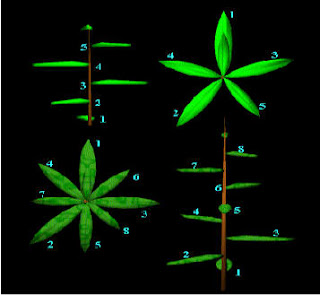Secrets of fibonacci series
The Fibonacci numbers are Nature's numbering system. They appear
everywhere in Nature, from the leaf arrangement in plants, to the pattern of
the florets of a flower, the bracts of a pinecone, or the scales of a
pineapple. The Fibonacci numbers are therefore applicable to the growth of
every living thing, including a single cell, a grain of wheat, a hive of bees,
and even all of mankind.
Plants do not know about this sequence - they just grow in the
most efficient ways. Many plants show the Fibonacci numbers in the arrangement
of the leaves around the stem. Some pine cones and fir cones also show the
numbers, as do daisies and sunflowers. Sunflowers can contain the number 89, or
even 144. Many other plants, such as succulents, also show the numbers. Some coniferous
trees show these numbers in the bumps on their trunks. And palm trees show the
numbers in the rings on their trunks.
Why do these arrangements occur? In the case of leaf arrangement,
or phyllotaxis, some of the cases may be related to maximizing the space for
each leaf, or the average amount of light falling on each one. Even a tiny
advantage would come to dominate, over many generations. In the case of
close-packed leaves in cabbages and succulents the correct arrangement may be
crucial for availability of space.
In the seeming
randomness of the natural world, we can find many instances of mathematical
order involving the Fibonacci numbers themselves and the closely related
"Golden" elements.
Fibonacci in Plants
Phyllotaxis is the
study of the ordered position of leaves on a stem. The leaves on this plant are
staggered in a spiral pattern to permit optimum exposure to sunlight. If we
apply the Golden Ratio to a circle we can see how it is that this plant
exhibits Fibonacci qualities. Click on the picture to see a more detailed
illustration of leaf arrangements.
By dividing a circle
into Golden proportions, where the ratio of the arc length are equal to
the Golden Ratio, we find the angle of the arcs to
be 137.5 degrees. In fact, this is the angle at which adjacent leaves are
positioned around the stem. This phenomenon is observed in many types of
plants.
In the case of tapered
pinecones or pineapples, we see a double set of spirals – one going in a
clockwise direction and one in the opposite direction. When these spirals are
counted, the two sets are found to be adjacent Fibonacci numbers.
Similarly, sunflowers
have a Golden Spiral seed arrangement. This provides a biological advantage
because it maximizes the number of seeds that can be packed into a seed head.
Inside the fruit of many
plants we can observe the presence of Fibonacci order.
The banana has 3 sections The apple has 5 sections
As well, many flowers
have a Fibonacci number of petals. Some, like this rose, also have Fibonacci,
or Golden Spiral, petal arrangements.
Branching plants
also exhibit Fibonacci numbers. Again, this design provides the best physical
accommodation for the number of branches, while maximizing sun exposure.
Fibonacci
Petals
3 petals
lily, iris
5 petals
buttercup, wild rose, larkspur, columbine
8 petals
delphiniums
13
petals
ragwort, corn marigold,
cineraria
21
petals
aster, black-eyed susan,
chicory
34
petals
plantain, pytethrum
55, 89
petals michelmas daisies,
the asteraceae family
The occurrence of
Fibonacci Numbers in Nature is interesting but the ratio of consecutive
Fibonacci Numbers is important.
Fibonacci in Animals
The shell of the
chambered Nautilus has Golden proportions. It is a logarithmic spiral.
The eyes, fins and tail
of the dolphin fall at Golden sections along the body.
A
starfish has 5 arms. (5 is the 5th Fibonacci number)
If a regular pentagon is
drawn and diagonals are added, a five-sided star or pentagram is formed. Where
the sides of the pentagon are one unit in length, the ratio between the
diagonals and the sides is Phi, or the Golden Ratio. This
five-point symmetry with Golden proportions is found in starfish.
Humans exhibit Fibonacci
characteristics, too. The Golden Ratio is seen in the proportions in
the sections of a finger.
It is also worthwhile to
mention that we have 8 fingers in total, 5 digits
on each hand, 3 bones in each finger, 2 bones
in 1 thumb, and 1 thumb on each hand.
The ratio between the forearm and the hand is the Golden Ratio!
The ratio between the forearm and the hand is the Golden Ratio!
The cochlea of the inner
ear forms a Golden Spiral.
The question must arise
as to why the golden proportion is special - and more importantly, is there any
difference between the Golden Proportion and another pleasing proportion? A
brief study of figures below will answer this question.
Thus the proportion of
the smaller to the greater is the same as the proportion of the greater to the
whole. The division of the line by point C thus represents a point of
equilibrium between these two proportions. If you move the point a fraction one
way or the other, then you have two proportions which are neither the same nor
are they in equilibrium. The only time that these two proportions are the same
is when they are Golden.
This point of division
is a mathematical confirmation of how the eye senses the balance of this
magical proportion that appears so frequently in nature and art.














Comments
Post a Comment
Your suggestions